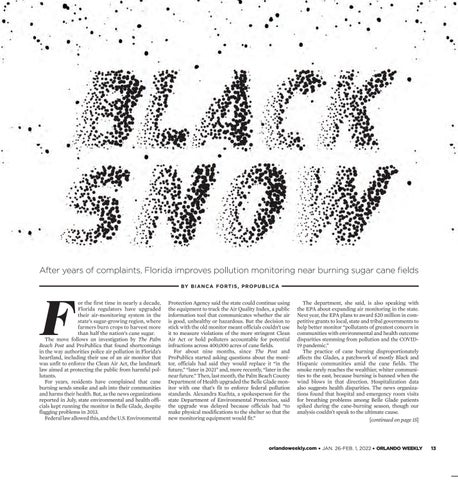After years of complaints, Florida improves pollution monitoring near burning sugar cane fields
F
or the first time in nearly a decade, Florida regulators have upgraded their air-monitoring system in the state’s sugar-growing region, where farmers burn crops to harvest more than half the nation’s cane sugar. The move follows an investigation by The Palm Beach Post and ProPublica that found shortcomings in the way authorities police air pollution in Florida’s heartland, including their use of an air monitor that was unfit to enforce the Clean Air Act, the landmark law aimed at protecting the public from harmful pollutants. For years, residents have complained that cane burning sends smoke and ash into their communities and harms their health. But, as the news organizations reported in July, state environmental and health officials kept running the monitor in Belle Glade, despite flagging problems in 2013. Federal law allowed this, and the U.S. Environmental
BY B I A N C A F O R TI S , P R O P U B L I C A
Protection Agency said the state could continue using the equipment to track the Air Quality Index, a public information tool that communicates whether the air is good, unhealthy or hazardous. But the decision to stick with the old monitor meant officials couldn’t use it to measure violations of the more stringent Clean Air Act or hold polluters accountable for potential infractions across 400,000 acres of cane fields. For about nine months, since The Post and ProPublica started asking questions about the monitor, officials had said they would replace it “in the future,” “later in 2021” and, more recently, “later in the near future.” Then, last month, the Palm Beach County Department of Health upgraded the Belle Glade monitor with one that’s fit to enforce federal pollution standards. Alexandra Kuchta, a spokesperson for the state Department of Environmental Protection, said the upgrade was delayed because officials had “to make physical modifications to the shelter so that the new monitoring equipment would fit.”
The department, she said, is also speaking with the EPA about expanding air monitoring in the state. Next year, the EPA plans to award $20 million in competitive grants to local, state and tribal governments to help better monitor “pollutants of greatest concern in communities with environmental and health outcome disparities stemming from pollution and the COVID19 pandemic.” The practice of cane burning disproportionately affects the Glades, a patchwork of mostly Black and Hispanic communities amid the cane fields. The smoke rarely reaches the wealthier, whiter communities to the east, because burning is banned when the wind blows in that direction. Hospitalization data also suggests health disparities. The news organizations found that hospital and emergency room visits for breathing problems among Belle Glade patients spiked during the cane-burning season, though our analysis couldn’t speak to the ultimate cause. [continued on page 15]
orlandoweekly.com
●
JAN. 26-FEB. 1, 2022 ● ORLANDO WEEKLY
13











